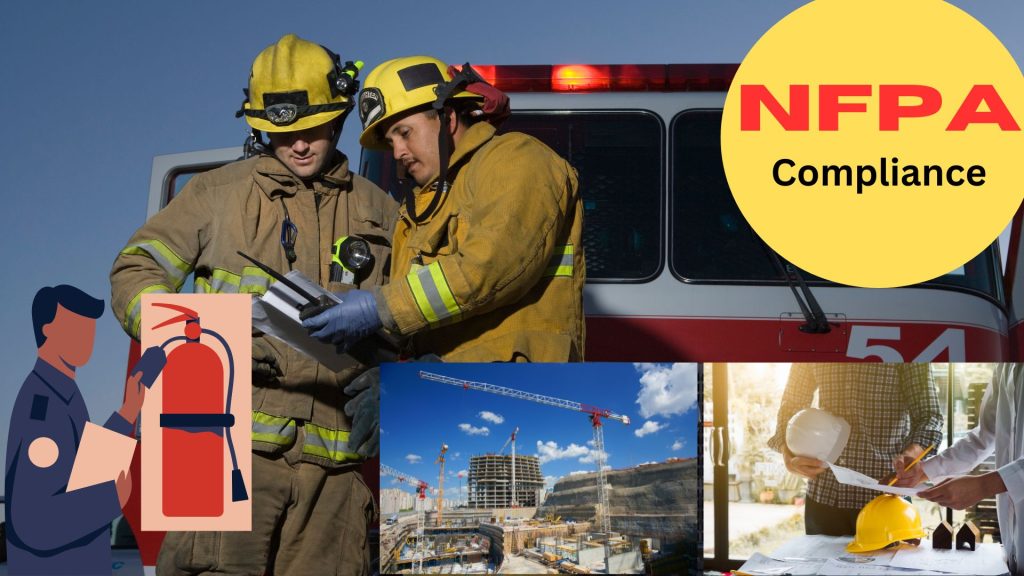Building fire safety norms and standards are developed by the National Fire Protection Association (NFPA). These laws and regulations are necessary to make sure that structures are built, maintained, and occupied in a way that reduces the risk of fire and safeguards the safety of residents and emergency personnel.
NFPA compliance is essential for a number of reasons. First of all, it aids in stopping flames before they start. Building owners and managers can make sure that their facilities are built with fire safety in mind and that all fire dangers are handled by adhering to the rules and standards established by the NFPA. This includes using fire-resistant materials, installing and maintaining fire protection systems correctly, and having sufficient egress.
Second, NFPA compliance lowers the possibility of fire-related injuries or fatalities in structures. Building owners and managers can make sure that inhabitants are informed of the occurrence of a fire and can safely exit the building by adhering to the criteria for fire safety systems. Sprinkler systems, which are properly installed and maintained fire prevention systems, can also aid in putting out flames before they cause substantial damage or spread to other parts of the building.

Different Types Of Fire Protection Systems
For the prevention and management of fires in structures, houses, and other facilities, fire protection systems are crucial. There are various different kinds of fire prevention systems that are frequently utilized, and each has special characteristics and advantages. An overview of the most prevalent types of fire protection systems is provided below:
One of the most popular kinds of fire protection systems are sprinkler systems. They are made up of a system of pipes with sprinkler heads that are intended to find and put out fires. The sprinkler heads turn on when there is a fire, which helps to contain and put out the fire by releasing water.
Fire Alarms: Another popular sort of fire safety equipment is the fire alarm. They are made up of a number of smoke and fire detection sensors and alarms. The alarm sounds to warn building inhabitants of the danger when smoke or fire is discovered.
Smoke Detectors: Similar to fire alarms, smoke detectors are made specifically to detect smoke. The smoke alarm sounds an alarm when it detects smoke, giving building occupants time to leave first before fire spreads.
Systems for suppressing fires: Fire control systems are made to put out fires by taking away one of the three things that make a fire start: oxygen, fuel, or heat. Spray systems, gas systems, and dry powder systems are a few types of fire suppression systems.
Fire extinguishers are small, portable appliances with the purpose of putting out small fires. They come in a variety of forms, each intended to put out fires sparked by various fuels, including paper, wood, or electrical apparatus.
Using fire-resistant materials to treat building materials is a form of fire prevention technology known as fireproofing. This can both help to stop fires from spreading and make it simpler to put out existing fires.
NFPA Codes and Standards-Based Regulations For Building Design And Construction
The National Fire Protection Association (NFPA) has created rules and standards to make sure that buildings are planned and constructed in a way that reduces the danger of fire. Building design and construction are essential elements of fire safety. Following is a summary of the NFPA codes and standards-based regulations for building design and construction:
Building Materials: The NFPA mandates that, if practicable, building materials be non-combustible and fire-resistant. High temperatures must be withstood by the materials utilized, and they must also prevent the spread of fire.
Means of Egress: According to the NFPA, buildings must have sufficient exits, stairwells, and escape routes. In order to ensure that inhabitants may safely and promptly evacuate the building in the event of a fire, these must be clearly marked and unobstructed.
Fire Protection Systems: The NFPA’s norms and standards must be followed while installing and maintaining fire protection systems, such as sprinklers, fire alarms, and smoke detectors. These systems must be made to promptly identify and put out flames, warn building residents of the fire’s presence, and offer escape routes.
Electrical Systems: The NFPA’s norms and standards must be followed when installing and maintaining electrical systems. Electrical equipment and wiring must be safeguarded against damage from overheating and engineered to prevent electrical fires.
HVAC systems must be properly installed, maintained, and engineered to stop smoke and fire from spreading throughout the entire structure. To avoid the development of dangerous gases, the NFPA mandates that HVAC systems have sufficient ventilation and air filtering.
To stop a fire from spreading, a building is divided into smaller, fire-resistant compartments by the technique of “fire separation.” In order to contain fires and stop them from spreading to other places, the NFPA mandates that buildings have adequate fire separation.
Fire Extinguishing Systems: The NFPA’s norms and standards must be followed while installing and maintaining fire extinguishing systems, such as fire hoses and portable fire extinguishers. These systems must be made to put out little fires quickly so that they don’t spread and do a lot of harm.
Finally, it is critical to NFPA compliance for buildings to ensure first responders’ safety. When reacting to fires, firefighters and other emergency responders depend on the building’s layout, construction, and safety features to keep them safe. It may be more dangerous for first responders and more challenging to control and put out a fire if a building is not up to code.
In conclusion, NFPA compliance is essential to preventing fires, reducing the chance of injury or death in the case of a fire, and safeguarding the safety of first responders. Building managers and owners are in charge of making sure that their buildings adhere to the NFPA’s regulations and standards and that continuing compliance is ensured through routine maintenance and inspections.
